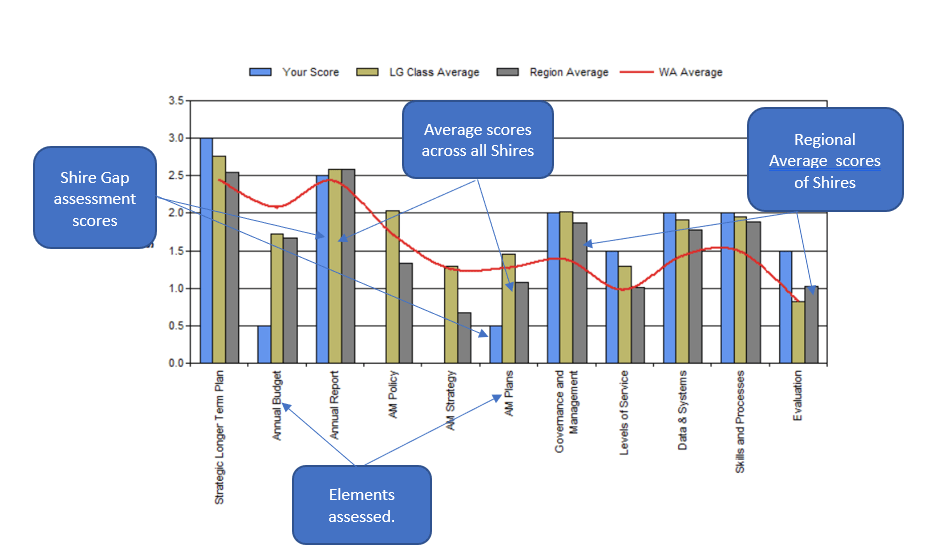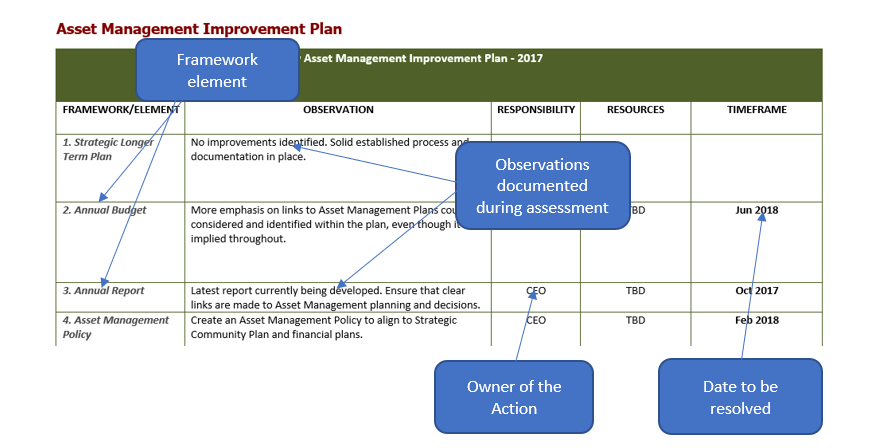The National Asset Management Assessment Framework (NAMAF) was developed by asset management professionals from across Australia under the guidance of the Australian Centre of Excellence for Local Government. The NAMAF provides a methodology for assessing the maturity of a local government asset management and financial planning processes. It comprises 11 elements against which local governments can self-assess their progress in implementing better practices, and develop improvement plans.
Although intended as a national program, implementation of the National Asset Management Assessment Framework has proceeded state by state, with the, then Western Australian Department of Local Government and Communities (DLGC), now Department of Local Government, Sports and Cultural Industries (DLGSC), launching a program in that state in February 2014 as an extension of their Integrated Planning and Reporting initiative that had been running 2009.
At or about the same time, ongoing assessment of asset management planning by DLGC highlighted the need to improve the accuracy of asset condition and useful life data.
To encourage take-up of the National Asset Management Assessment Framework and start the journey to better understand asset condition and useful life, in April 2014 DLGC launched a project to support the 75 country local governments in Western Australia to carry out an assessment using the NAMAF and to assist local government officers to assess and update condition and remaining useful life data for one asset class using best practice asset condition assessment processes and updating Asset Management Plans (AMPs) and Long Term Financial Plans (LTFPs).
To deliver the project, the DLGC established a panel of suitably qualified asset management specialists and funded their participation to support the various local governments
With a strong background in asset management maturity assessment and development of asset management plans, we were well placed to support the program, and were selected as a part of the project panel. We have now assisted 12 West Australian Local Governments to conduct NAMAF self-assessments, now sponsored by DLGSC, and to develop Asset Management Plans for their most critical asset classes.
Delivering asset management support for country local governments
The Asset Management Support Program consists of two separate phases of work. Phase 1 is to conduct a maturity assessment using the National Asset Management Assessment Framework to identify gaps and opportunities, and develop an improvement action plan to close the gaps. Phase 2 is conducted a later stage and is used to assess progress on the initial improvement plan, and also to train, mentor and support the council in condition assessment practices and how this data is used to inform Asset Management Plans and Long Term Financial Plans (LTFP).
These phases are described in more detail below.
Phase 1
Phase 1 introduces the National Asset Management Assessment Framework (NAMAF) and its associated assessment tools, and uses the assessment process and its outcomes to identify improvement opportunities and develop time-linked actions and clear accountability for completion which are captured as an Asset Management Improvement Plan (AMIP). Although development of the plan is facilitated by the consultant, it is up to the Local Government to deliver those actions as steps in the continuous improvement of their Asset Management Plan (AMP).
The 11 elements covered by the National Asset Management Assessment Framework are:
- Strategic plan
- Annual budget
- Annual report
- AM Policy
- AM Strategy
- AM Plans
- Governance
- Levels of Service
- Data and systems
- Skills and processes
- Evaluation
Each element is graded against a four-level maturity scale which ranks each element from ‘Not substantially progressed’ to ‘substantially Progressed’. The appropriate ranking is determined using a series of statements and questions to ensure consistency between evaluations.
The final part of the initial phase is to develop an Asset Management Improvement Plan (AMIP) which documents the improvements identified throughout the initial gap assessment.
Following the completion of the assessment, a report is produced which shows the current assessed maturity of the Local government and the improvement action plan. It also shows how that Local Government compares against other Western Australian Local Governments in order to benchmark where they are against their fellow councils and assess possible areas of opportunity and collaboration. The report needs to be approved and signed off by the CEO of the Local Government before any further work commences and the second phase of the project is commissioned by the DLGSC.
Below are two examples of the reports produced for the Local governments as part of the Phase 1 deliverables. Figure 1 shows maturity across the 11 areas compared against other Shires within WA. This provides the Shire CEO with a snap shot of how they are performing compared against other Shires in their region and demonstrates potential opportune ties to collaborate with other close regional Shires. Figure 2 is a snapshot of an Improvement action plan. They key final part of the report which provides the Shire with areas of Asset Management they need to work on before Phase 2 is carried out.


Phase 2
The second phase consists of a number of different objectives:
- Review the AMIP as created as part of Phase 1 and see if any actions have been carried out. This provides us with an idea of how the Shire has progressed with its Asset Management practices and whether actions are being owned.
- Rescore each area of the National Asset Management Assessment Framework scoring assessments criteria as carried out in Phase One. Which areas have been improved upon and which have not.
- Carry out Condition monitoring principles training on one specific asset class. The aim of this is to assist the Shire with in assessing and rating the condition of one class of their infrastructure assets.
- Based on the training assist the Shire with understanding how accurate Asset data will then be fed into both the Shires AMP’s and LTFP and the knock-on effects that this beneficiary information will have on how the Shire manages its assets.
- A final report showing the areas of support the Shire still requires in order to continue to develop best practice Asset Management in the future.
The Assetivity Advantage
We have a strong track record in assisting asset intensive businesses to realise maximum value from their asset base. Established in 2001, we have worked with a range of industries across Australia and globally to identify improvement opportunities, develop pragmatic and implementable solutions, and assist with execution.
As early adopters of the ISO 55000 Asset Management principles, we are thought leaders in asset management assessment, strategic asset management planning, and development of asset management plans.
Our 13-part series on implementing ISO55000 has had tens of thousands of hits, as has our implementation eBook. Our free Strategic Asset Management Plan (SAMP) and Asset Management Plan templates are similarly popular and our public asset management training courses are always well attended.
The NAMAF assessment and improvement planning process is a logical extension of this expertise and well aligned to our core business, as is providing training, coaching and support in asset condition assessment and asset management plan development.
Hence we were the consultants of choice to support the DGLC program.
Conclusion
DLGC’s objective in funding the project was to expose local governments to the National Asset Management Assessment Framework as a key improvement tools, and to help them establish process to better understand asset condition and plan accordingly. This aligned well with our desire to educate clients rather than doing the work for them and leaving them with documentation that they do not understand or serves no purpose and does not meet the objectives as set out by the DLGSC.
Following the delivery of both phases local governments should be competent at managing their Asset Management processes and practices and be able to update their asset information with more confidence. This will ensure that money is being spent in the right place to ensure the customers’ requirements are being met. Local governments will also be more confident in providing accurate data to the DLGSC as part of the Integrated Planning Framework Requirements.
If you would like more information or assistance on establishing effective asset management within your local government organisation, please contact us.
Ready to get the best value from your assets?
We offer a comprehensive range of consulting services relating to maintenance, reliability and asset management. If your needs are comparatively straight forward, we have standardised approaches for delivering these services that provide demonstrated results as quickly and cost-effectively as possible. Browse our services below to explore how we can help to achieve your goals.
